Saving Big Mammals Fights Extinction and Climate Change
By bringing back just 20 large mammalian species to landscapes across the globe, scientists say we can make huge dents in the biodiversity and climate crises. Here’s how.
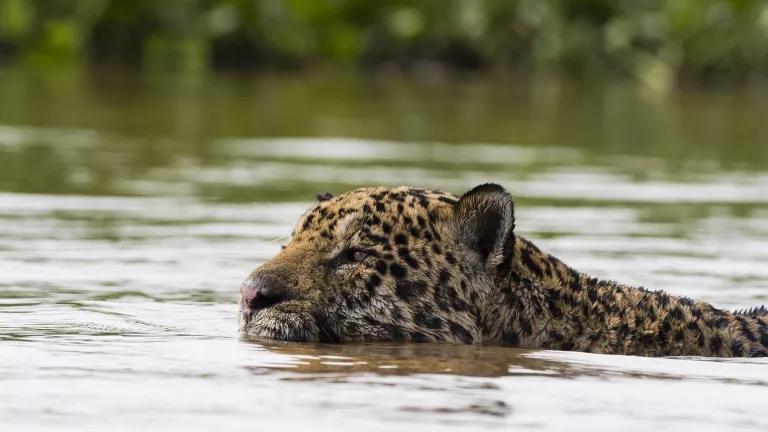
Jaguar swimming in a river in Mato Grosso, Brazil
Think of every species as a pebble tossed into a lake. Everything a species does—what it eats, where it lives, how much it poops—radiates outward, eventually merging with the ripples of everything else living in its ecosystem.
And while every class of creature has an important role to fulfill, in the grand scheme of things, there are the species that create ecological ripples and then there are the ones that create ecological tidal waves.
“Large-bodied mammals tend to have an overabundant importance in their ecosystems,” says biologist Carly Vynne, lead author of a new study published in the journal Ecography and director of biodiversity and climate for the nonprofit RESOLVE.
Large mammals make tidal waves, but unfortunately, a great many of them are currently missing in action. According to the study, intact assemblages of large mammals are present in just 15 percent of the planet’s land mass (parts of the Amazon rainforest and Arctic, for example). These are the only places that still have their full cast of big beasts—unlike the rest of the world, where mammal populations have thinned out due to habitat loss, hunting, climate change, or any of the other common drivers of extinction.
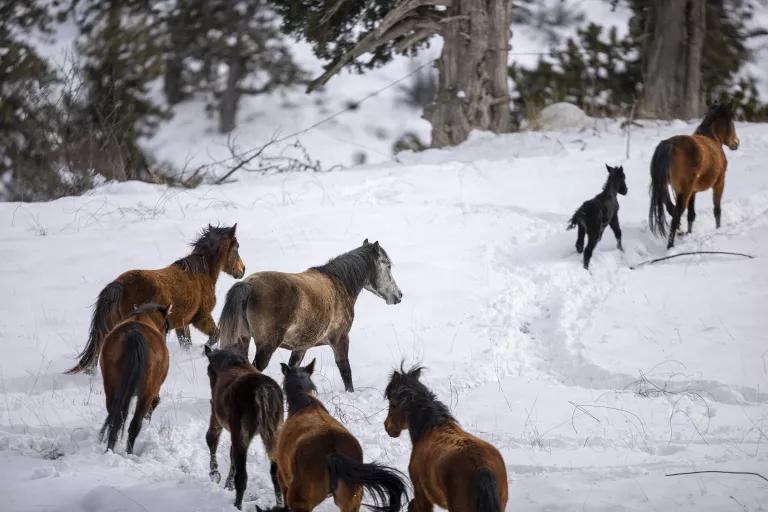
This isn’t just bad news for the mammals themselves—it’s a blow to the battle against climate change, because biodiversity and climate are linked. Forests with wolves store vastly more carbon than those without, and those with tigers store carbon at a rate three times higher than forests that have lost their tigers. In South America, large mammals like tapirs reseed carbon-sequestering rainforests as they trot around pooping out seeds. Likewise, when an area’s biodiversity is robust, it can help animals better weather the effects of things like climate-induced ocean acidification or extinction cascades that are created by the loss of keystone species.
These are just a few of the reasons why many experts now say we need to conserve at least 30 percent of the world’s land and 30 percent of the world’s oceans by the year 2030 if we’re going to stave off mass extinction, climate change, and general planetary disaster. (You may know the effort as the 30x30 Initiative.) In the United States, a bipartisan coalition of lawmakers are also trying to pass something known as the Recovering America’s Wildlife Act. If signed into law, it would provide $1.4 billion each year to bolster new and existing efforts to conserve the nation’s struggling plant and animal species.

The plan to bring back big mammals
Fortunately, the Ecography study’s authors have formulated a plan to help us get there—and it’s just one example of the kind of transformative change that is needed to reach our climate goals and ensure our own survival on this planet.
From wolverines to white-lipped peccaries, the scientists identify 20 mammals that, if restored to their former glory in their ecosystems, could increase the area of the world’s current intact mammal assemblages by a whopping 54 percent. This includes restoring large mammals to places where they no longer exist while also protecting spaces where they can continue to thrive. This could be done by building corridors between fragmented habitats and providing protections that would allow large mammal populations to naturally expand their ranges and find new mates. Depending on the area, mitigating hunting pressures, rewilding native vegetation, and making sure there are enough smaller critters for predators to eat may also be necessary.
If you’re wondering why the focus is on mammals—and not fish, insects, birds, or reptiles, there are a few reasons. For one, there’s historically been more research on mammals, so the scientists have enough reliable data to support these sorts of calculations. Two, for better or worse, people tend to rally around the fluffy ones. And, of course, there’s also scientific explanations.

The importance of large-bodied predators
Vynne says one well-known example of this is mammalian apex predators, such as the dhole or jaguar. Every time apex predators feed, they subtly change the composition of the world around them—and not just by keeping prey populations in check.
One study conducted in the Greater Yellowstone Ecosystem in 2017 showed that when a mountain lion (puma) kills an elk, it provides food not just for itself, but for 39 species of birds and mammals, including Steller’s jays, deer mice, and black bears. Zoom in a little closer, and scientists have learned that a single cougar kill site can provide food and shelter for more than 200 species of beetle, in addition to slugs, snails, flies, and a variety of other micro beasts.
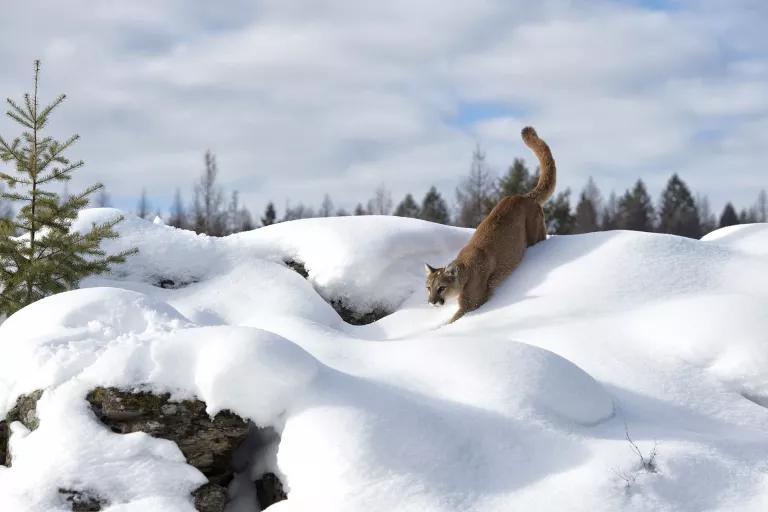
By the study’s estimates, restoring mountain lions to parts of their native range where there’s already good habitat could bring these sorts of ecosystem services to more than 180,000 square miles in North, Central, and South America. Together, that would be an area about the size of Sweden.
Big cats, along with other listed species like black bears and brown bears, have large historical ranges and adapt well to changes in landscapes, climates, and types of food, so the benefits of bringing their numbers up can be far-reaching. A healthy mountain lion population, for instance, could positively impact 34 distinct ecoregions within the Americas. So restoring these animals doesn’t just help boost biodiversity in one particular area but, potentially, across a region.
How plant eaters shape the landscape
Charismatic predators like bears, jaguars, and tigers, of course, can’t take all the credit. Plant-eating mammals also play outsize roles in ecosystem health. Take the American and Eurasian bison, which also rank among the 20 mammals.
“As a keystone species, bison influence the landscape in ways that benefit many plant and wildlife communities,” says Amy McNamara, director for NRDC’s Northern Rockies wildlife project.
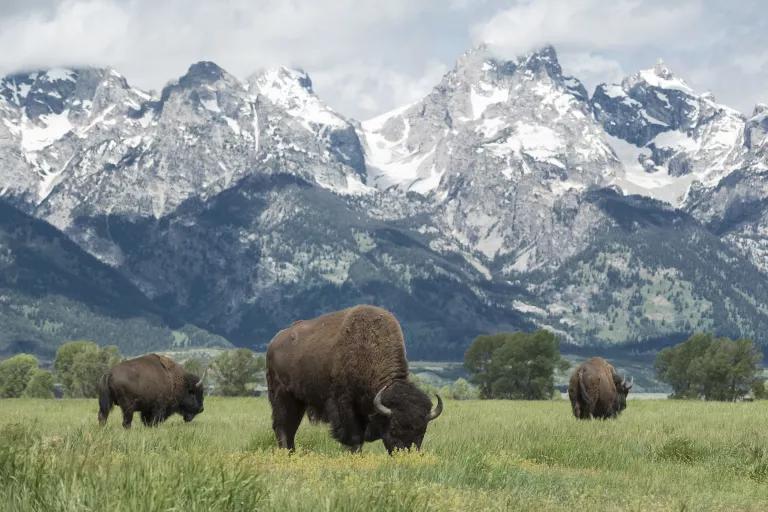
With spade-shaped hooves, bison till the soil as they roam across grasslands, making little nurseries in which important native plants, such as blue grama, sand dropseed, and little bluestem, take root. The bison also transport the seeds of these plants around in their thick fur and fertilize them with their dung. And believe it or not, bison can serve as important pollinators. Their long beards dust flowers with pollen as the animals graze. Bison wallows, formed by the animals over time as they roll in mud and alter the landscape, also create microhabitats where water collects and insects, amphibians, and reptiles make their homes. These mini watering holes make a convenient place to stop for a drink too.
“We know that when bison are restored to grasslands, songbirds thrive,” says McNamara, who is working to extend habitat for wild bison beyond places like Yellowstone National Park. For instance, one study found that where bison graze, vesper sparrows and grasshopper sparrows are more abundant. Magpies will also ride atop these lumbering herbivores, picking insects out of their fur, while sharp-tailed grouse and burrowing owls benefit from the way bison mow down vegetation and open up access to the prairie floor.
In North America, restoring bison could ecologically benefit half a million square miles—an area larger than the size of Peru that would include 32 different ecoregions.
Other landscape architects on the list include moose, wild horses, dama gazelles, and hippopotamuses. But you don’t have to weigh 2,000 pounds to make a difference.
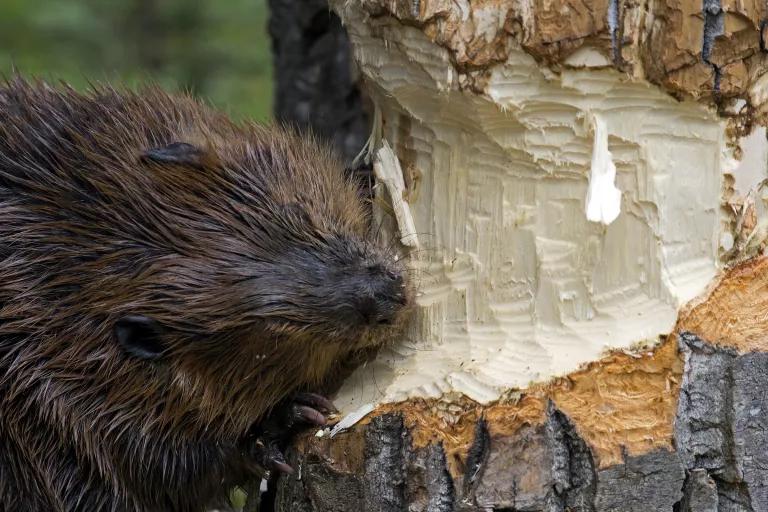
Take the Eurasian beaver that tips the scales at 66 pounds, which is even smaller than its American cousin. “Beavers are in some ways the ultimate keystone species—an animal whose impact on the ecosystem just creates life wherever it goes,” says Ben Goldfarb, author of Eager: The Surprising, Secret Life of Beavers and Why They Matter.
Now, beavers may seem an unlikely choice for an animal that can save the day, but the world’s second-largest rodent is kind of a secret genius. By damming up free-flowing streams, “beavers create speed bumps that slow the flow of water way down,” says Goldfarb. This completely alters the hydrology of the area.
During large storms, beaver dams prevent downstream flooding. On the flip side, beaver dams can lessen the effects of drought by increasing the height of the water table, releasing water slowly and sustaining stream flows throughout the year. In the American West, beaver dams also serve as refuges for animals during wildfires and can even stop the flames from spreading.
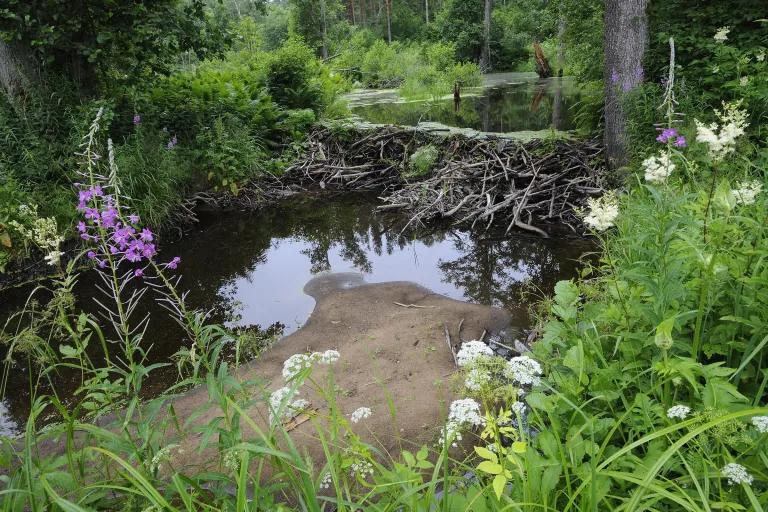
“Beaver meadows reconnect floodplains and increase carbon sequestration,” says McNamara. This is because dams stockpile carbon-rich sediments and submerged wood, which decays much more slowly than when the same materials are exposed to the air. This prevents the resulting carbon dioxide from entering the atmosphere—at least as long as the dams remain intact. “And the nice part about beavers?” she says. “They do all of this work for free.”
Making preparations to welcome big mammals
To be clear, no one is saying that restoring even one of these species will be easy, but who ever said saving the world would be?
“For some species, there are biological challenges, like not dispersing naturally or reproducing slowly,” says Vynne. “But I would say those challenges are very little compared to making sure that the communities that choose to have these species restored are ready.”
For beavers, this might mean wrapping certain trees in wire to prevent the animals from felling them, says Goldfarb, or installing so-called “beaver deceiver” devices that stop the rodents from damming up necessary drainage pathways, like culverts. Similarly, predators, such as jaguars and grizzlies, require willingness on the part of nearby residents and livestock ranchers, but there are various ways communities can adapt to coexisting with large wild mammals. Livestock protection dogs, fladry, and range riders (people who follow herds on horseback) are a few helpful deterrents, while things like electric fences, motion lights, and keeping pets indoors can go a long way toward safeguarding people.
“At the end of the day, it’s about not putting all of your eggs in one basket,” says Vynne. “We need to give species different chances in different places to assemble and reassemble and move and migrate.”
“And the longer we wait, the fewer chances there will be.”
This NRDC.org story is available for online republication by news media outlets or nonprofits under these conditions: The writer(s) must be credited with a byline; you must note prominently that the story was originally published by NRDC.org and link to the original; the story cannot be edited (beyond simple things such as grammar); you can’t resell the story in any form or grant republishing rights to other outlets; you can’t republish our material wholesale or automatically—you need to select stories individually; you can’t republish the photos or graphics on our site without specific permission; you should drop us a note to let us know when you’ve used one of our stories.
1.5 Degrees of Global Warming—Are We There Yet?
Can Anything Be Done to Stop Overfishing?
Biodiversity 101
1.5 Degrees of Global Warming—Are We There Yet?
Can Anything Be Done to Stop Overfishing?
Biodiversity 101
1.5 Degrees of Global Warming—Are We There Yet?
Can Anything Be Done to Stop Overfishing?
Biodiversity 101
1.5 Degrees of Global Warming—Are We There Yet?
Can Anything Be Done to Stop Overfishing?